Siracode Signal Co.: Difference between revisions
ArxCyberwolf (talk | contribs) (Moved page over from the CDS Wiki.) |
ArxCyberwolf (talk | contribs) |
||
| (6 intermediate revisions by 3 users not shown) | |||
| Line 1: | Line 1: | ||
{{Infobox manufacturer|caption=|names=Siracode Signal Corporation|hq=San Francisco, CA|founder=John H. Rosseter?|key_people=John H. Rosseter | {{Infobox manufacturer|caption=Siracode's logo.|names=Siracode Signal Corporation|hq=San Francisco, CA|founder=John H. Rosseter?|key_people=John H. Rosseter | ||
Ralph R. McClure|founded=1926|defunct=1933|products=Vehicular sirens | Ralph R. McClure|founded=1926|defunct=1933|products=Vehicular sirens | ||
Stationary electric sirens | Stationary electric sirens | ||
Industrial sirens|succeeded=[[E.D. Bullard Co.|E.D. Bullard Co.]]|title=Siracode Signal Corporation}}'''Siracode Signal Corporation''' was a manufacturer of vehicular, industrial, and large outdoor warning sirens, based in San Francisco, CA. They were, most notably, the first manufacturer to design their sirens with tapered rotors and stators. Having purchased [[Heath Engineering Laboratories, Inc.|Heath Engineering Laboratories]] in 1926, Siracode started out backed by a reputable name in the market. | Industrial sirens|succeeded=[[E.D. Bullard Co.|E.D. Bullard Co.]]|title=Siracode Signal Corporation|image=Siracode_logo.png}}'''Siracode Signal Corporation''' was a manufacturer of vehicular, industrial, and large outdoor warning sirens, based in San Francisco, CA. They were, most notably, the first manufacturer to design their sirens with tapered rotors and stators. Having purchased [[Heath Engineering Laboratories, Inc.|Heath Engineering Laboratories]] in 1926, Siracode started out backed by a reputable name in the market. | ||
Despite this, Siracode lasted less than 10 years before the [[E.D Bullard Co.|E.D. Bullard Company]] bought and sold their designs, which made many more sales. Because of this, Siracode sirens are very difficult to come across today. Around five Siracodes are known to exist today, none of which are outdoor sirens, and all are in the hands of collectors. | Despite this, Siracode lasted less than 10 years before the [[E.D. Bullard Co.|E.D. Bullard Company]] bought and sold their designs, which made many more sales. Because of this, Siracode sirens are very difficult to come across today. Around five Siracodes are known to exist today, none of which are outdoor sirens, and all are in the hands of collectors. | ||
== History == | == History == | ||
[[File:Siracode McClure design.jpg|left|thumb|159x159px|The original Siracode patent drawings, designed by Ralph McClure.]] | |||
The origin of Siracode dates back to September 17th, 1925, with a patent designed by Ralph R. McClure, and applied for by John Henry Rosseter, who in 1926 would end up being the president of the company. The patent displays a new type of siren, which uses a tapered rotor and stator assembly instead of a normal cylindrical siren. The rotor 8 port, with a curved intake ring and rotor floor. With the help of a narrow parabolic projector horn, this revolutionary new siren projected sound forward in one direction unlike any other siren produced at the time. Siracode sirens were referred to as the "searchlight of sound" because of this characteristic. The tapered rotor and stator made it very easy for the siren to be even louder with closer tolerances, as the rotor could be slid forward extremely close to the stator without worry of scraping. A unique coding mechanism for the sirens was also developed, utilizing a stator sleeve that had holes for the ports and intake, which immediately silenced the siren when turned by a solenoid, which at the time was a revolutionary design in coding sirens. | The origin of Siracode dates back to September 17th, 1925, with a patent designed by Ralph R. McClure, and applied for by John Henry Rosseter, who in 1926 would end up being the president of the company. The patent displays a new type of siren, which uses a tapered rotor and stator assembly instead of a normal cylindrical siren. The rotor 8 port, with a curved intake ring and rotor floor. With the help of a narrow parabolic projector horn, this revolutionary new siren projected sound forward in one direction unlike any other siren produced at the time. Siracode sirens were referred to as the "searchlight of sound" because of this characteristic. The tapered rotor and stator made it very easy for the siren to be even louder with closer tolerances, as the rotor could be slid forward extremely close to the stator without worry of scraping. A unique coding mechanism for the sirens was also developed, utilizing a stator sleeve that had holes for the ports and intake, which immediately silenced the siren when turned by a solenoid, which at the time was a revolutionary design in coding sirens. | ||
| Line 16: | Line 17: | ||
=== Vehicular Sirens === | === Vehicular Sirens === | ||
[[File:Siracode Midget.png|thumb|162x162px|A Siracode Midget siren.]] | |||
==== Midget ==== | ==== Midget ==== | ||
The Midget was the smallest vehicular siren sold by Siracode. The rotor size and port count is unknown, as the only photo of one is from the rear. One Midget is known to exist. | The Midget was the smallest vehicular siren sold by Siracode. The rotor size and port count is unknown, as the only photo of one is from the rear. It consists of a conical rotor/stator attached to a small DC motor, with a projector fitted around the rotor/stator. One Midget is known to exist in private possession. | ||
[[File:Siracode D8 Junior.png|left|thumb|149x149px|A Siracode D-8 Junior siren, taken from a 1926 Siracode advertisement.]] | |||
==== D-8 Junior ==== | ==== D-8 Junior ==== | ||
| Line 24: | Line 27: | ||
=== Community PROTECTORS === | === Community PROTECTORS === | ||
[[File:Siracode R40.png|thumb|151x151px|A Siracode R-40 Duplex, taken from a 1930 newspaper. A coding mechanism can be seen.]] | |||
==== R-40 "Duplex" ==== | ==== R-40 "Duplex" ==== | ||
The R-40 is a double-end, 3 horsepower bi-directional siren. It is 7 port with two, presumably, 12 inch diameter rotors. The R-40 could be equipped with the unique ball-bearing coding mechanism, which was driven by two separate solenoids to create a coded signal with a sharp cutoff. It has two large projectors to help focus the sound to only two directions. One R-40 is known to have been installed as a fog signal on a bridge in 1930, but none are known to exist today. | The R-40 is a double-end, 3 horsepower bi-directional siren. It is 7 port with two, presumably, 12 inch diameter rotors. The R-40 could be equipped with the unique ball-bearing coding mechanism, which was driven by two separate solenoids to create a coded signal with a sharp cutoff. It has two large projectors to help focus the sound to only two directions. One R-40 is known to have been installed as a fog signal on a bridge in 1930, but none are known to exist today. | ||
[[File:Siracode S40.png|left|thumb|152x152px|A Siracode S-40 siren, taken from a 1930 newspaper.]] | |||
==== S-40(H) ==== | ==== S-40(H) ==== | ||
The S-40, or S-40H, is a single end, 5 horsepower uni-directional siren. It is a 6 port with a 16½ inch diameter rotor. The S-40 could be equipped with the unique ball-bearing coding mechanism, which was driven by a large solenoid to create a coded signal with a sharp cutoff. It has an extremely large projector to focus the sound in one direction. Four S-40s are known to have been installed as fog signals, opposing each other to cover two areas. None are known to exist today. | The S-40, or S-40H, is a single end, 5 horsepower uni-directional siren. It is a 6 port with a 16½ inch diameter rotor. The S-40 could be equipped with the unique ball-bearing coding mechanism, which was driven by a large solenoid to create a coded signal with a sharp cutoff. It has an extremely large projector to focus the sound in one direction. Four S-40s are known to have been installed as fog signals, opposing each other to cover two areas. None are known to exist today. | ||
While only two large Siracode models are listed here currently, the company offered at least three sizes and many more configurations for Community Protector sirens. It is unknown just how many sirens were available, but the company presumably offered omni-directional sirens as well. These will hopefully be uncovered in the future. | While only two large Siracode models are listed here currently, the company offered at least three sizes and many more configurations for Community Protector sirens. It is unknown just how many sirens were available, but the company presumably offered omni-directional sirens as well. These will hopefully be uncovered in the future.[[File:Navy Siracode.png|thumb|149x149px|A privately owned Siracode Navy siren. The face reads, "SIRACODE, S.F. CALIF."]] | ||
=== Industrial Sirens === | === Industrial Sirens === | ||
==== Navy Siren ==== | ==== Navy Siren ==== | ||
Siracode produced a handful of special sirens for use with the U.S. Navy, though no model name is known, as the only tag on the siren is the one for the motor. These were able to be flush-mounted into a wall, with the rotor and stator sticking out. Presumably, they could also be equipped with a projector. They are 1/8 horsepower, with a 4 inch diameter, 8 port rotor. It has a brass stator, which makes for an extremely unique look. The siren also has a Navy stamp in the motor frame. Two are known to exist today, both in private ownership. It was later sold by E.D. Bullard, starting in 1934, as the Navy Type Q. | Siracode produced a handful of special sirens for use with the U.S. Navy, though no model name is known, as the only tag on the siren is the one for the motor. These were able to be flush-mounted into a wall, with the rotor and stator sticking out. Presumably, they could also be equipped with a projector. They are 1/8 horsepower, with a 4 inch diameter, 8 port rotor. It has a brass stator, which makes for an extremely unique look. The siren also has a Navy stamp in the motor frame. Two are known to exist today, both in private ownership. It was later sold by E.D. Bullard, starting in 1934, as the Navy Type Q. | ||
==== Unknown industrial siren (¼H) ==== | |||
[[File:Siracode 14h.png|thumb|162x162px|A Siracode industrial siren, shown in an early E.D. Bullard advertisement.]] | |||
While nothing is known about this siren, it appears to be Siracode's predecessor to E.D. Bullard's ¼H industrial/vehicular siren. It was shown in an early E.D. Bullard advertisement, but shows Siracode's face lettering, indicating that this is either a recycled photo from Siracode, or an unchanged Siracode model that Bullard sold for a short period before rebranding it. | |||
== John H. Rosseter == | == John H. Rosseter == | ||
[[File:John H. Rosseter.png|left|thumb|154x154px|John H. Rosseter, c. 1928]] | |||
'''John Henry Rosseter''' (August 6th, 1868 - April 28th, 1936) was an entrepreneur, horseman, and an operations director for the United States Shipping Board. He became the president of Siracode Signal Co. shortly after they opened in 1926, seeing the opportunity to take advantage of rising demand for sirens. | '''John Henry Rosseter''' (August 6th, 1868 - April 28th, 1936) was an entrepreneur, horseman, and an operations director for the United States Shipping Board. He became the president of Siracode Signal Co. shortly after they opened in 1926, seeing the opportunity to take advantage of rising demand for sirens. | ||
| Line 45: | Line 54: | ||
By the mid 1920s, despite now being the president of Siracode Signal Co., Rosseter's main focus shifted to continuing his business with racing horses. On his Rancho Wikiup property, purchased in 1912, he would now devote the majority of his time to breeding fine show horses and racing horses, as well as sometimes racing them himself. Rosseter was most well-known by his business in racing horses, gaining national respect and winning over one million dollars in prizes. When horse racing was made illegal, he strongly advocated for it to be legalized, using his high local status to help gain him traction on the matter. | By the mid 1920s, despite now being the president of Siracode Signal Co., Rosseter's main focus shifted to continuing his business with racing horses. On his Rancho Wikiup property, purchased in 1912, he would now devote the majority of his time to breeding fine show horses and racing horses, as well as sometimes racing them himself. Rosseter was most well-known by his business in racing horses, gaining national respect and winning over one million dollars in prizes. When horse racing was made illegal, he strongly advocated for it to be legalized, using his high local status to help gain him traction on the matter. | ||
In December 1933, while still spending most of his time a horseman, Rosseter was stricken with an unknown illness. This thrust him into retirement, which included closing and selling assets from Siracode. He fought his illness for over two years, but finally succumbed on April 28th, 1936 at age 67. He left behind his second wife, Alice G. Rosseter, who passed away 12 years later at 59. His home and horse stable, Rancho Wikiup (4900 Carriage Ln. Santa Rosa, CA) unfortunately burned down by wildfire in 2017. | In December 1933, while still spending most of his time a horseman, Rosseter was stricken with an unknown illness. This thrust him into retirement, which included closing and selling assets from Siracode. He fought his illness for over two years, but finally succumbed on April 28th, 1936 at age 67. He left behind his second wife, Alice G. Rosseter, who passed away 12 years later at 59. His home and horse stable, Rancho Wikiup (4900 Carriage Ln. Santa Rosa, CA) was unfortunately burned down by a wildfire in 2017. | ||
[[Category:Company pages]] | |||
[[Category:Defunct Manufacturers]] | |||
[[Category:Electromechanical Sirens]] | |||
[[Category:Omnidirectional Sirens]] | |||
[[Category:Industrial Small Sirens]] | |||
[[Category:Coded Sirens]] | |||
__INDEX__ | |||
Latest revision as of 20:28, 20 October 2024
| Siracode Signal Corporation | |
 Siracode's logo. | |
| Names | Siracode Signal Corporation |
|---|---|
| Headquarters | San Francisco, CA |
| Founder | John H. Rosseter? |
| Key people | John H. Rosseter
Ralph R. McClure |
| Founded | 1926 |
| Defunct | 1933 |
| Products | Vehicular sirens
Stationary electric sirens Industrial sirens |
| Succeeded by | E.D. Bullard Co. |
Siracode Signal Corporation was a manufacturer of vehicular, industrial, and large outdoor warning sirens, based in San Francisco, CA. They were, most notably, the first manufacturer to design their sirens with tapered rotors and stators. Having purchased Heath Engineering Laboratories in 1926, Siracode started out backed by a reputable name in the market.
Despite this, Siracode lasted less than 10 years before the E.D. Bullard Company bought and sold their designs, which made many more sales. Because of this, Siracode sirens are very difficult to come across today. Around five Siracodes are known to exist today, none of which are outdoor sirens, and all are in the hands of collectors.
History
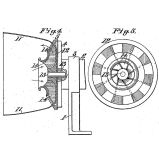
The origin of Siracode dates back to September 17th, 1925, with a patent designed by Ralph R. McClure, and applied for by John Henry Rosseter, who in 1926 would end up being the president of the company. The patent displays a new type of siren, which uses a tapered rotor and stator assembly instead of a normal cylindrical siren. The rotor 8 port, with a curved intake ring and rotor floor. With the help of a narrow parabolic projector horn, this revolutionary new siren projected sound forward in one direction unlike any other siren produced at the time. Siracode sirens were referred to as the "searchlight of sound" because of this characteristic. The tapered rotor and stator made it very easy for the siren to be even louder with closer tolerances, as the rotor could be slid forward extremely close to the stator without worry of scraping. A unique coding mechanism for the sirens was also developed, utilizing a stator sleeve that had holes for the ports and intake, which immediately silenced the siren when turned by a solenoid, which at the time was a revolutionary design in coding sirens.
On April 21st, 1926, the Heath Engineering Laboratories company was successfully renamed to "Siracode Signal Corporation." Backed by the reputable name of Heath, and by the funds of millionaire owner John Rossiter, the future of Siracode seemed bright. Siracode brought in decent sales with their vehicular sirens, with the larger D-8 Junior seeing widespread use across California. However, their outdoor sirens saw a different story; while the sirens themselves functioned fine, the controllers gave customers persistent issues. For instance, a Siracode "Community PROTECTOR" installed in Taft, CA failed to sound 4 days after installation, and remained silent for 3 weeks up until it was returned to the company. The only Siracode known to reliably serve a community was installed in Fairfax, CA, which only worked presumably because it was paired to a Gamewell coding system instead of a Siracode controller.
Because of these problems, Siracode never saw much success. Besides vehicular sirens, Siracode saw lots of their sales in custom developed industrial sirens for the U.S. Navy, and large coded sirens used as fog horns on bridges. In 1933, Rosseter began suffering an illness, and was forced into retirement. This final blow meant the end for Siracode, and the rights to their designs were sold to the E.D. Bullard Company, who started building Siracode rebrand sirens as early as 1934. Under production at E.D. Bullard, the Siracode designs saw much more success with slight modifications to improve siren performance and reliability. No large Siracodes are currently known to exist, and there are no more than five small sirens known to exist presently.
Products
Vehicular Sirens
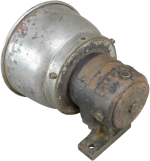
Midget
The Midget was the smallest vehicular siren sold by Siracode. The rotor size and port count is unknown, as the only photo of one is from the rear. It consists of a conical rotor/stator attached to a small DC motor, with a projector fitted around the rotor/stator. One Midget is known to exist in private possession.
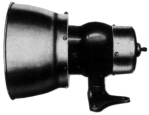
D-8 Junior
The D-8 Junior was the largest vehicular siren sold by Siracode. The exact rotor size is unknown, but presumably, it would have been around 6 inches. The D-8 Junior came in high and low tone configurations, which appear to be 7 port and 11 port, though that is not fully confirmed. The D-8 Junior was fitted with a large bowl shaped projector to focus the siren's sound directly forwards and prevent any unwanted side or rear projection. Two D-8 Junior sirens are known to exist.
Community PROTECTORS
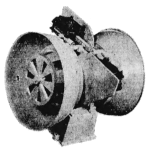
R-40 "Duplex"
The R-40 is a double-end, 3 horsepower bi-directional siren. It is 7 port with two, presumably, 12 inch diameter rotors. The R-40 could be equipped with the unique ball-bearing coding mechanism, which was driven by two separate solenoids to create a coded signal with a sharp cutoff. It has two large projectors to help focus the sound to only two directions. One R-40 is known to have been installed as a fog signal on a bridge in 1930, but none are known to exist today.
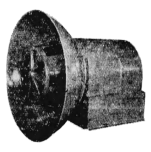
S-40(H)
The S-40, or S-40H, is a single end, 5 horsepower uni-directional siren. It is a 6 port with a 16½ inch diameter rotor. The S-40 could be equipped with the unique ball-bearing coding mechanism, which was driven by a large solenoid to create a coded signal with a sharp cutoff. It has an extremely large projector to focus the sound in one direction. Four S-40s are known to have been installed as fog signals, opposing each other to cover two areas. None are known to exist today.
While only two large Siracode models are listed here currently, the company offered at least three sizes and many more configurations for Community Protector sirens. It is unknown just how many sirens were available, but the company presumably offered omni-directional sirens as well. These will hopefully be uncovered in the future.
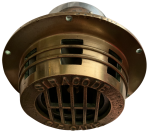
Industrial Sirens
Siracode produced a handful of special sirens for use with the U.S. Navy, though no model name is known, as the only tag on the siren is the one for the motor. These were able to be flush-mounted into a wall, with the rotor and stator sticking out. Presumably, they could also be equipped with a projector. They are 1/8 horsepower, with a 4 inch diameter, 8 port rotor. It has a brass stator, which makes for an extremely unique look. The siren also has a Navy stamp in the motor frame. Two are known to exist today, both in private ownership. It was later sold by E.D. Bullard, starting in 1934, as the Navy Type Q.
Unknown industrial siren (¼H)
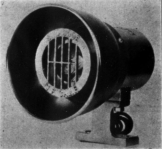
While nothing is known about this siren, it appears to be Siracode's predecessor to E.D. Bullard's ¼H industrial/vehicular siren. It was shown in an early E.D. Bullard advertisement, but shows Siracode's face lettering, indicating that this is either a recycled photo from Siracode, or an unchanged Siracode model that Bullard sold for a short period before rebranding it.
John H. Rosseter
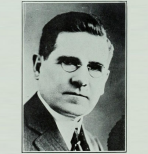
John Henry Rosseter (August 6th, 1868 - April 28th, 1936) was an entrepreneur, horseman, and an operations director for the United States Shipping Board. He became the president of Siracode Signal Co. shortly after they opened in 1926, seeing the opportunity to take advantage of rising demand for sirens.
Rosseter was born in Brooklyn, New York, but moved to San Francisco with his family during his childhood. At 13, he began working as an office boy at W.R. Grace & Co., and had night tutoring instead of going to school. By 18, Rosseter became the Pacific Coast manager for W.R. Grace, a position he held for 40 years. In addition to this, he held president positions for both the Pacific Mail Steamship Co. and the Sperry Flour Co., and was a widely respected United States Shipping Board director, positions he all retired from around 1920. In the early-mid 1920s, he owned the self-titled John H. Rosseter Company, which among other things, seemed to mainly specialize in radio work. In 1924, an engineer for the company installed a radio station in Mazatlan, Mexico, which was the most powerful radio in Mexico at that time.
By the mid 1920s, despite now being the president of Siracode Signal Co., Rosseter's main focus shifted to continuing his business with racing horses. On his Rancho Wikiup property, purchased in 1912, he would now devote the majority of his time to breeding fine show horses and racing horses, as well as sometimes racing them himself. Rosseter was most well-known by his business in racing horses, gaining national respect and winning over one million dollars in prizes. When horse racing was made illegal, he strongly advocated for it to be legalized, using his high local status to help gain him traction on the matter.
In December 1933, while still spending most of his time a horseman, Rosseter was stricken with an unknown illness. This thrust him into retirement, which included closing and selling assets from Siracode. He fought his illness for over two years, but finally succumbed on April 28th, 1936 at age 67. He left behind his second wife, Alice G. Rosseter, who passed away 12 years later at 59. His home and horse stable, Rancho Wikiup (4900 Carriage Ln. Santa Rosa, CA) was unfortunately burned down by a wildfire in 2017.